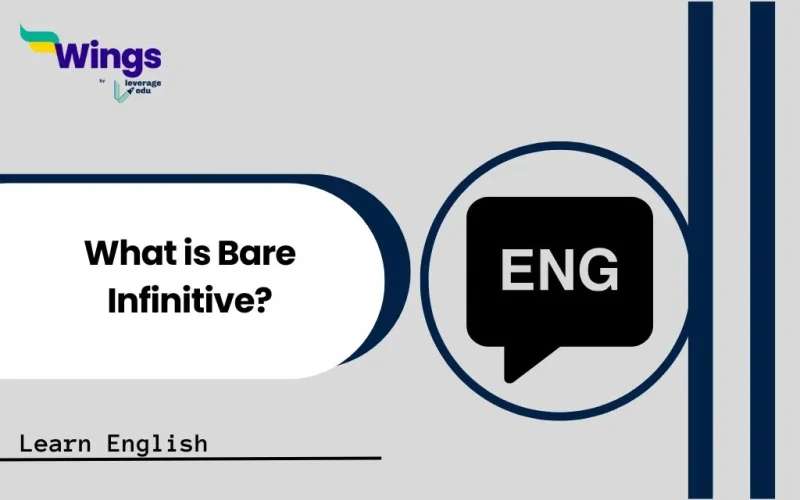A bare infinitive is the base form of a verb, without the particle to. For example, in the sentence He can play, play is the bare infinitive. It is used after modal verbs, causative verbs, and perception verbs. In this article, we will explain what is bare infinitive, how it functions, provide examples, and highlight the difference between bare infinitives and to-infinitives.
This Blog Includes:
What is ‘Bare Infinitive’ in English Grammar?
In English grammar, the bare infinitive is the base form of a verb (like go, do, see, eat) without “to” in front of it. It’s called “bare” because it’s just the plain form, not the “to-infinitive” (like to go, to see, etc.).
Here are some examples of bare infinitives:
- She made him cry.
- I heard them sing.
- You must try harder.
- Let him go.
Explore: What are Participles in English Grammar?
When to Use the ‘Bare Infinitive’?
The bare infinitive is used after modal verbs, perception verbs, causative verbs, and in commands or instructions. It also follows expressions like ‘had better’ and appears in suggestions that begin with why. To know more, let us explore when to use bare infinitives in English grammar.
1. Use Bare Infinitive After Modal Verbs
Modal verbs are helping verbs that express necessity, possibility, permission, or ability. They are always followed by a bare infinitive, never a full infinitive with ‘to’. You can use bare infinitives after modal verbs like can, could, may, might, must, shall, should, will, and would.
Examples:
| Example Sentences | Modal Verbs | Bare Infinitives |
| You must study. | must | study |
| He can drive. | can | drive |
2. Use Bare Infinite After Perception Verbs
Perception verbs indicate actions that are directly witnessed from start to finish. With the use of the bare infinitive, emphasis is laid on the completeness of the observed action. You can use bare infinitives after perception verbs like see, hear, feel, watch, and notice when the whole action is observed.
| Example Sentences | Perception Verbs | Bare Infinitives |
| I saw him run across the field. | saw | run |
| We heard her sing at the concert. | heard | sing |
3. Use With Auxiliary Verb – ‘Do’ and ‘Don’t’
The auxiliary verb do is used in questions, negative sentences, and for emphasis. It is always followed by a bare infinitive.
| Example Sentences | Auxiliary Verbs | Bare Infinitives |
| Do you know the answer? | do | know |
| I don’t understand the question. | don’t | understand |
4. Use of Bare Infinitive in ‘Commands’
While giving someone a command or an instruction (Imperative Sentences), we generally start the sentence directly with the action word. This action verb here is called a bare infinitive because it comes without ‘to’ and without any subject like ‘you’.
| Example Sentences | Type of Sentence | Bare Infinitives |
| Close the door. | Command | close |
| Please sit down. | Request | sit |
5. Use Bare Infinitive After ‘Had Better’ and ‘Would Rather’
Some phrases like ‘had better” and would rather’ are used when we want to give advice or say what someone prefers. After these phrases, we always use a bare infinitive, which means the verb comes without ‘to’.
| Complete Sentence | Phrase Used | Bare Infinitives |
| You had better drink water, it’s very hot outside. | had better | drink |
| I would rather stay home today than go out. | would rather | stay |
How to Identify ‘Bare Infinitive’ in a Sentence?
After learning ‘What is a Bare Infinitive in English Grammar’, let us identify a bare infinitive in a sentence, you need to follow these simple steps:
Step 1: Identify Verbs Followed by Bare Infinitives
Some common verbs such as make, let, help (sometimes), see, hear, feel, watch, notice, dare (sometimes), had better, and would rather, are followed by another verb without the word ‘to.’
Examples:
i) She made me cry.
In the above example, she made me cry, The verb cry is a bare infinitive because it follows made.
Step 2: Check for Modal Verbs
Modal verbs like can, could, may, might, must, shall, should, will, and would are always followed by a bare infinitive.
i) You should study harder.
In the above example sentence You should study harder, the verb study is a bare infinitive after the modal verb should.
Step 3: Differentiate Between Bare and Full Infinitive
A full infinitive in a sentence includes the word to before the verb, like to eat or to go. A bare infinitive, however, is just the verb without the word to, like eat or go. The key difference between the two is that if the verb is followed by to, it’s a full infinitive and if there is no to, it is a bare infinitive.
Example:
I want to read.
In the sentence I want to read, the verb read is used with to before it, making it a full infinitive. A full infinitive is when you see the word to in front of the verb, for instance, to read or to eat.
Also Read: Gerund, Infinitive and Participle Worksheet: Master Verbals with Practice
Differences Between To-Infinitive, Bare Infinitive, Gerund
The to-infinitive, base form of the verb, and gerund are three different verb forms in English, each used in distinct ways. The to-infinitive involves adding to before the verb; the base form is simply the verb without to, and the gerund is the verb ending in –ing and functions as a noun. Understanding their differences helps in choosing the right form for specific situations in sentences.
Difference Between Bare Infinitive and To-Infinitive
| Feature | Bare Infinitive | To-Infinitive |
| Structure | The bare infinitive consists only of the base form of the verb without the word to. | The to-infinitive always includes the word to before the base form of the verb. |
| Usage with Modals | The bare infinitive is used after modal verbs such as can, must, and should. | The to-infinitive is never used after modal verbs as this would be grammatically incorrect. |
| With Perception Verbs | The bare infinitive follows perception verbs like see and hear when describing a complete action. | The to-infinitive is not used after perception verbs when describing actions witnessed in their entirety. |
| As Subject/Complement | The bare infinitive rarely functions as the subject or complement of a sentence. | The to-infinitive commonly functions as the subject or complement in sentences. |
| Purpose Expression | The bare infinitive cannot be used to express purpose or intention. | The to-infinitive frequently expresses purpose or intention in sentences. |
Difference Between Bare Infinitive and Gerund
| Feature | Bare Infinitive | Gerund |
| Form | The bare infinitive uses only the base form of the verb without any additions. | The gerund adds the suffix -ing to the base form of the verb. |
| Function | The bare infinitive functions as a verb complement in specific constructions. | The gerund functions grammatically as a noun while retaining verbal characteristics. |
| Preposition Compatibility | The bare infinitive cannot follow prepositions in standard English grammar. | The gerund commonly follows prepositions in phrases and expressions. |
| Possessive Modification | The bare infinitive cannot be modified by possessive adjectives or nouns. | The gerund can be modified by possessive adjectives or nouns to show who performs the action. |
| Aspect Expression | The bare infinitive does not express continuous or ongoing action on its own. | The gerund inherently conveys a sense of ongoing activity or process. |
Also Read: Difference Between Gerund, Infinitive and Participle: Definition, Example, Exercises
List of Verbs as Bare Infinitives: Examples
The bare infinitive is the base form of a verb without the particle to.
It is used in various grammatical structures, such as after modal verbs, causative verbs, and in imperative sentences. Below is a list of common verbs that are typically used in the bare infinitive form. Understanding these verbs helps in using the correct verb form in different contexts.
| Category | Verbs |
| Action Verbs | walk, run, jump, swim, eat, drink, sleep, write, read, speak, listen, think, help, work, play, drive, fly, climb, dance, sing |
| Communication Verbs | say, tell, ask, answer, explain, describe, discuss, argue, shout, whisper, inform, declare, announce, mention, state |
| Mental Process Verbs | know, understand, learn, remember, forget, believe, consider, decide, choose, plan, analyze, evaluate, imagine, doubt, realize |
| Movement Verbs | come, go, move, turn, stand, sit, lie, rise, fall, enter, exit, arrive, depart, return, leave |
| Basic Verbs | be, have, do, make, get, take, give, put, find, use, let, keep, hold, set, bring |
| Change Verbs | become, grow, develop, change, increase, decrease, improve, worsen, transform, evolve, alter, modify, adjust, shift, vary |
| Sense Verbs | see, hear, feel, smell, taste, touch, sense, notice, observe, watch, perceive, detect, recognize, distinguish, identify |
| Emotional Verbs | love, hate, like, dislike, enjoy, fear, hope, trust, worry, care, prefer, regret, appreciate, admire, respect |
| Possession Verbs | own, possess, belong, contain, include, lack, need, want, desire, wish, acquire, obtain, gain, lose, keep |
| Creation Verbs | create, build, construct, design, develop, produce, generate, form, shape, craft, compose, write, draw, paint, invent |
Bare Infinitive Verb List PDF
To help you more with a list of Bare Infinitive Verb, find the PDF format below:
Practice Exercise for Bare Infinitive
Instructions: Fill in the blank with the correct bare infinitive verb from the box below.
Use each word only once.
| go, help, do, let, come, play, watch, sleep, speak, eat |
1. My parents don’t ___ me stay up late.
2. I saw her ___ a movie last night.
3. You should ___ more vegetables every day.
4. Can you ___ me with my homework?
5. We heard the teacher ___ loudly in the hall.
6. They made us ___ the project again.
7. I will not ___ you enter the exam room without your ID.
8. We watched the kids ___ in the park.
9. Let’s ___ for a walk after dinner.
10. Don’t ___ too late, you have a test tomorrow.
Answers:
| 1. Let 2. Watch 3. Eat 4. Help 5. Speak 6. Make 7. Let 8. Play 9. Go 10. Sleep |
‘What is Bare infinitive in English Grammar’ may seem tricky at first, but once you get the hang of them, they become easy to use. They help make your sentences shorter and sound more natural. By learning and practicing these verbs, you are taking one more step toward becoming better at English. So, keep exploring, keep practising, and soon you’ll be using them without even thinking!
Explore some Learn English topics below:
FAQs
Ans. A bare infinitive is the base form of a verb without “to,” used after modals and perception verbs. A finite verb, however, shows tense, subject agreement, and can stand alone in a sentence.
Ans. Yes, dare can be a bare infinitive. It is used without to in constructions like I dare say” or “He dared not speak. In these cases, dare functions as a modal-like verb.
Ans. Here is a list of 10 examples of bare infinitives:
i. She can sing beautifully.
Ii. They must leave before sunset.
Iii. You should study for the test.
Iv. We might go to the beach later.
v. He will help you with your homework.
vi.I could see him walking down the street.
vii.Please don’t touch the exhibit.
viii.Why not try a different approach?
ix. They had better hurry to catch the train.
x. I would rather wait for her here.
We hope this blog on ‘What is Bare Infinitive ‘was informative and helped you improve your English skills. You can also follow the Learn English page of Leverage Edu for more exciting and informative blogs related to English grammar and the English language.
 One app for all your study abroad needs
One app for all your study abroad needs















 60,000+ students trusted us with their dreams. Take the first step today!
60,000+ students trusted us with their dreams. Take the first step today!

